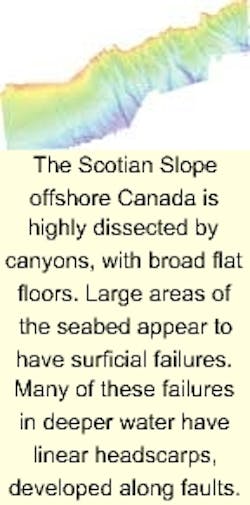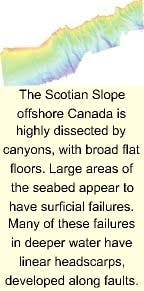Geosciences
Farther, wider, and deeper
This month marks the new millennium - another 1,000-year segment of human history. As we look forward into the new century, humanity continues to seek the benefits of human-directed energy usage. Demand for all forms of manufactured energy continues to rise and for the foreseeable future that appetite will be fed primarily by fossil fuels.
Geo-humans have a constant interest and desire to seek the unknown, the new, the distant, and to recognize the order that exists in the Earth's internal systems. The world's population needs the inquisitiveness, the skill, and the willingness to accept risks that all such explorers share.
Many of you remember the space race of the 1960s that culminated in putting people on the Moon. You may also remember a projection of the future in the movie 2001: A Space Odyssey. This vision took the zeitgeist of the time, the impulse to explore, and extended it farther away from our home planet, and deeper than ever before, into the unknown reaches of our local planetary system.
It was a quest to discover what an outwardly directed signal meant. It required humans to seek new knowledge, to test the unknown, to remotely investigate new worlds, and to go as far as possible. It required new tools, not the least of which was the sentient computer, HAL (from the movie). It was a societal quest ultimately focused through one explorer's courage. The petroleum industry has a similar challenge (not quite so grand, but every bit as intricate and exciting) to:
- Go farther outward over hostile oceans
- Understand the earth's formative processes
- Drill deeper into ocean sediments than ever before.
The great leap of the past ten years has taken us from the continental shelf margins well out into waters beyond 3,000 meters. The next few years will take us to deeper waters and deeper sediments. We cannot personally go to those depths, but we can:
- Remotely sense it
- Send our proxies into it
- Extract the needed resources from it.
It is a grand vision to serve fellow humans and develop the energy sources needed. Distribution of those resources is the responsibility of other parties and societal equities are for other minds; we should not be distracted by those challenges. Our challenge and focus is to locate the needed resources, but going farther, looking deeper, and understanding more completely.
This quest was aptly undertaken at the recent Gulf Coast Section-Society of Economic Paleontologists and Mineralogists (GCS-SEPM) Research Conference on Deepwater Reservoirs of the World. Papers on recent exploration and development of primarily clastic reservoirs were presented. Regions examined included the Gulf of Mexico, South America, North Sea, West Africa, and Southeast Asia.
A recurring theme was the uniqueness of each reservoir and the imperative to understand each system's architecture. Reservoir types tested to date separate into three major types: sheet sands, amalgamated channels, and channel-levee systems (in that order of increasing complexity).
About two-thirds of developed deepwater reservoirs are in sheet sand systems. To date 1.5 billion bbl of crude has been developed from these reservoirs, but over nine billion bbls have been found in deepwater reservoirs. Clearly, major resources remain to be located and developed in the years ahead.
Technology
Collaboration tool
GeoQuest (Schlumberger Oilfield Services), along with Collaboration Technology Ltd., introduced the MindSharetrademark collaborative knowledge capture tool. The software enables exploration and production (E&P) project teams to capture knowledge, share information and collaborate online. The tool provides collab-orating teams with an intuitive, cross-platform canvas for creating, publishing, updating and viewing of any data. Project workflow can be captured as a report, enabling the project to be reviewed, shared and archived. Mike Badley, President of Collaboration Technology, said, "MindShare will assume a central role in the capture, organization, sharing and dissemination of information across the spectrum of E&P work practices. Wide deployment in E&P organizations will generate significant cost savings by stream-lining these work practices."
PC/LINUX processing
CGG announced Geoclustertrademark, the port of GeovecteurPlustrademark to the PC platform using the LINUX operating system. The LINUX version offers many advantages including lower maintenance costs, wider availability of computers, lower overall hardware costs, greater flexibility in installing computer systems, and faster turnaround times. CGG Borehole Services has been using the system to process VSP data since early 2000. During the first quarter of 2001, the remaining GeovecteurPlus elements will be ported to LINUX. Contact David Jones at [email protected] or Tel: + 33 1 64 47 38 75.
Exploration
Canadian bathymetry
C & C Technologies completed a multibeam bathymetry and imagery survey of the Canadian Scotian Slope. Marathon, Murphy, Norsk Hydro, and PanCanadian sponsored the non-exclusive survey, which encompassed 28,000 sq km of the lease blocks ranging in depth from 600 to 3,500 meters. The multibeam bathymetry data has a pixel size of approximately 30 meters that reveals the complex morphology of the seabed. The imagery is being used for a regional assessment of seabed erosion and the distribution of failures throughout the slope. Contact [email protected].
Malteze trenches
TGS-NOPEC announced the start of a combined non-exclusive/contract 2D program offshore Malta. The 9,000-km survey will cover some of the deep trenches in Sicily Channel as well as most of Malta's continental shelf. A 1,000-km contract survey covering Hardman Resources' License Area 3, Blocks 4 and 5 will be incorporated in the planned survey grid. Data from this survey will be available during first quarter 2001.

